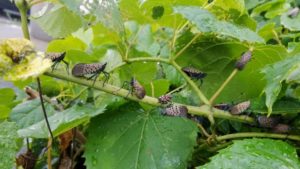Staying Strong! 2024 State of the Fruit and Nut Industry Survey Results Are In
Despite ever-increasing input costs — combined with preexisting labor issues and extreme weather conditions that are bordering on becoming the norm — U.S. fruit and nut growers largely remain confident in 2024. Nearly 88% of all grower respondents to American Fruit Grower’s 2024 (ninth-annual) State of the Fruit and Nut Industry Report indicate they are either increasing production this season (43.7%) or maintaining their 2023 strategy (43.9%).
The fact that only 12% are decreasing production in 2024 speaks to typical grower resiliency. The 2023 season was far from bountiful, with more than a quarter of all survey respondents — a category-high 27% — reporting a production decrease of more than 10% in 2023.
Why such optimism in the face of uncertainty? Why reluctance in other cases? Reasons vary across the crop categories covered by American Fruit Grower.
BERRIES
Most optimistic, by far, are berry growers across the board. Four of the five most popular berry types — elderberry (64%), strawberry (58%), blackberry (57%), and raspberry (51%) — are increasing in production by more than 50%. Not one other individual fruit or nut can claim likewise.
“Dark fruits are very popular right now,” a Montana grower of raspberry, strawberry, honeyberry, jostaberry, and Saskatoon serviceberry says.
“We’re seeing an increase in demand for elderberries, so we thought we would add a few bushes to see how it goes for sales and potentially add even more in following years,” a Wisconsin berry grower says.
Fourteen percent of raspberry growers are introducing the crop this season, which helps place the berry at No. 9 among the most popular crops overall in this report and second among berries. “We’re adding raspberries to increase our varieties,” a Tennessee berry grower says.
Strawberries are a story unto themselves. With 58% of growers increasing production and only 4% going in the opposite direction, the No. 10 fruit boasts a net production gain of 54%.
“We’re running out of flat land for strawberries. Otherwise, we would plant more,” a Georgia pome fruit grower says.
When asked about their biggest nursery issues, berry growers in Minnesota and Iowa cite a lack of hardy strawberry varieties and lack of strawberry plant vendors, respectively.
Blueberry, the most prevalent berry and third-most popular fruit overall behind apple and peach, is still gaining in popularity with an expected production increase of 46% and survey-low decrease of only 3%.
When asked what the best thing growers did to improve profits in 2023, a Washington state tree fruit grower credits his recent addition of blueberry bushes. A California berry grower lauds his decision to keep his blueberry pick-your-own open for more hours.
A Pennsylvania berry grower, touching on his most profitable crop, recommends blueberries and “more of them.” Meanwhile, a Michigan blueberry specialist is replacing older varieties with those that boast higher quality and better consumer appeal. “We are revitalizing our blueberry acreage,” he says.
POME FRUIT
Despite the ever-increasing popularity of berries, the top 1-2 punch in the U.S. fruit and nut growing industry among our survey respondents remains apple (No. 1 overall) and pear (No. 4). Combined, pome fruit growers represent 37% of the primary crop responses in this report. Berry growers are second at 22%, followed by the producers of stone fruit (18%), nuts (10%), and grapes (8%).
Apple production, despite the increasing problem of oversupply, is not slowing down overall. Six percent of growers are introducing the crop this season, and 38% are increasing production. Only 13% are decreasing production, resulting in a net gain of 31%.
Growers credit multiple varieties as being breadwinners – largely ‘Honeycrisp’, ‘Evercrisp,’ and ‘Gala’, in order of prominence. Says one New York grower: “‘Honeycrisp’, ‘Evercrisp’, ‘Fuji’ — people want a hard, crisp, sweet apple.”
“‘Honeycrisp’ and heirloom varieties — hype surrounding the former and exclusivity around the latter,” a Maine grower says.
“‘Honeycrisp’ and ‘Arkansas Black’ — those trees are picked bare every year by U-pickers,” a New Jersey grower adds.
As for ‘Evercrisp’, the variety “stores really well and eats good through the winter,” according to a Michigan grower.
“For most folks, ‘Honeycrisp’ is what they want more than anything else, although I am having more and more customers ask where my ‘Evercrisp’ are in September and October, preferring them over ‘Honeycrisp’,” a Pennsylvania grower says.
Not all apple growers, particularly regarding ‘Honeycrisp’, are pleased with the current environment.
“The No. 1 problem in the apple industry right now is oversupply, which is depressing prices,” a New York apple grower says. “Outside investment money complicates everything as growers need to remove acreage of varieties in which demand is decreasing. Outside investors (and growers who fail to determine their actual costs — do not understand that the more they produce, the lower the returns. Washington state is in the process of killing the golden goose — ‘Honeycrisp’.”
The report’s pear numbers are like its apple numbers: 7% of growers are introducing the crop, another 29% are increasing production, and only 14% are subtracting production or discontinuing the crop.
“We’re introducing pear trees for wine and brandy production,” a New York berry grower says.
When asked what specific tree fruit is most profitable now, growers from Tennessee, North Carolina, Pennsylvania, Wisconsin, Washington, and Oregon cite pear, including Asian pears. Narrowed down to varieties, they mention ‘Bartlett’ (because of its cannery demand, according to a California grower), ‘D’Anjou’, and Asian varieties ‘Olympic’, ‘New Century’, and ‘Chojuro’.
“I’m going to high density in a new 4-acre block and adding Asian pears,” a New Jersey grower says. “The install is ongoing, but it’s looking promising!”
Meanwhile, other growers in New Hampshire, Pennsylvania, Oregon, and California have recently opted to discontinue or significantly reduce their pear production.
“We stopped growing pear,” a Wisconsin grower says. “The disease issue was not worth it.”
“We’re reducing our pear production and replacing it with apples,” an Oregon grower says. “It’s working out great.”
STONE FRUIT
The precarious field of stone fruit growing, hindered last year by widespread frost and freeze conditions, is nonetheless nearly as optimistic about the future as their pome fruit and berry grower counterparts. Peach, sweet cherry, and plum/prune growers – representing three of the six most popular fruits in the survey overall — are looking at respective 39%, 30%, and 31% net increases in production this year.
“We are bringing back sweet cherries,” a Georgia tree fruit grower says. “We’re going to give it another try with a different growing system and newer chemistries.”
“Apples have not been very profitable, so we are trying to transition to peaches and row crops that we can sell directly to the public,” a Utah tree fruit grower says.
“Our toughest decision was when to start replacing old peach trees,” a Nevada stone fruit grower says. “It has worked out well.”
Tart cherry growers refuse to submit to their industry’s longstanding slump. While 12% are discontinuing their crops and another 9% downsizing, 47% are operating under the status quo, and 32% are even increasing production.
For a Rhode Island pome fruit grower, adding tart cherries last season was his most difficult decision. “I was against it,” he says, “but they are progressing well.”
In Michigan, however, a tart cherry grower has decided to discontinue his crop, saying “I don’t see a path for us to be successful in the tart cherry industry. It’s not our primary crop and doesn’t provide enough revenue as a viable diversification crop.”
NUTS
All is not rosy in the fruit and nut growing universe. While 23% of walnut growers plan to increase production, 20% are planning to decrease production and another 25% — a survey high — are discontinuing the crop altogether. Meanwhile, no surveyed growers are planting walnuts this year.
“Growers’ returns are about 25% of production costs is the reason for discontinuing walnuts! Between the costs of inputs, taxes, and more regulations here in California, it doesn’t look good!” a western Sacramento Valley grower says. “It seems that everyone along the marketing chain is making money except the growers. We are receiving whatever money is left over after processing and sales cost.”
“Walnuts are not profitable. We removed acreage,” a California grower who was “seriously impacted” by extreme rain/flooding in 2023 says.
Adds a third California grower (who plans to increase almond and olive production): “Walnut prices are becoming obsolete. We might want to rip out the trees and plant another crop.”
Almond growers are far more content — only 12% are decreasing or discontinuing production despite the fact 53% of them experienced at least a 10% reduction in production in 2023.
“We’re making sure every input is done with utmost efficiency,” one grower says.
“Efficiency: We’re building relationships with financial folks to allow us to continue to produce until the market recovers to traditional prices,” a San Joaquin County grower says.
GRAPE
Wine grape growers, with a lukewarm net production increase of 12%, seem to be in a wait-and-see mode: no new plantings but no discontinued vines. A little more optimistic are the growers of table grapes (30% net increase) and juice grapes (37%).
“The price to farm and the price being paid are not in alignment,” a California wine grape grower says. “Grape price per ton is not increasing with expenses and inflated economy.”
Adds a fellow Californian: “Frost and extreme heat continue to be a major concern. Consumers are drinking less alcohol, reducing the demand for wine grapes.”
“Cannabis is taking a big chunk out of our market,” another California grape grower says.
As a New York grape grower sums up: “Fruit growing has been a rollercoaster ride for my 50-year career and entire life as I was raised among 1,000 acres of apples, cherries, peaches, plums, and prunes. There’s no way to get rich except land accumulation and long, long days in the orchards.”
Scroll through the slideshow above to see some results from the 2024 State of the Fruit and Nut Industry Survey. Stay tuned for more insights from the 2024 State of the Fruit and Nut Industry report in the coming weeks.





















